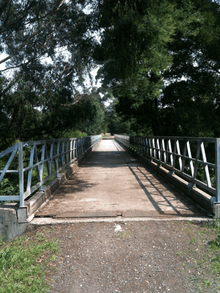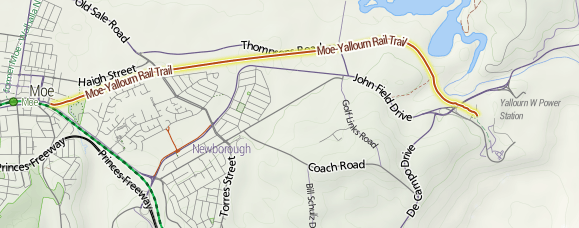Yallourn railway line
There were two separate railway lines servicing Yallourn, the first branching from Hernes Oak, a junction situated between Moe and Morwell, which was in service from 1922-1955. The second Yallourn railway line junctioned at Moe and was in service from 1953-1986. Both were broad gauge branch railways from the main Gippsland line in Victoria, Australia. Operated by the Victorian Railways and successors, the lines served the State Electricity Commission of Victoria operated Yallourn Power Station, open cut mine, and briquette factory complex; as well as the adjacent company town of Yallourn. The alignment of the first line has been lost due to the expansion of the Yallourn open cut mine. The second line is now part of the Moe to Yallourn Rail Trail.
History
The first railway line was opened in January 1922 to transport briquettes from the briquette production operations at Yallourn to Melbourne, in addition to transport supplies to the power station located beside the coal mine.[1] The line branched from the main line at Hernes Oak, initially with a staff locked set of points and a loop siding,[2] being altered to include a crossing loop, siding, and signal box when traffic increased.[3]
In later years outward traffic from the briquette works increased, and an electrification program for the Gippsland line was put into place as part of Operation Phoenix. Further complications arose as expansion plans for the Yallourn open cut mine encroached on the existing alignment, and along with the presence of 1:50 gradients it was decided to rebuild the line to Yallourn along a new alignment. Work started in 1949 but was hampered by labour shortages, with the next 9.7 km long line on a 1 in 110 grade brought into service in September 1953.[1] The electrification of the new line was not commissioned until September 1955, when the main line to Melbourne was complete. The old route via Hernes Oak was initially retained, with down empty to trains using it, with loaded trains using the new line to return to Melbourne. A new signal box at Yallourn marshalling yard was opened in December 1953, allowing two way operation on the new line, the old line falling into disuse but not removed until March 1957 when the SECV begun to expand the Yallourn open cut mine across the alignment.[1] At the Hernes Oak end part of the former line was retained as a dead end siding.[4]
Despite the expansion of the mine, briquette traffic begun to decline, with power generation at Yallourn growing in demand instead. Due to the decrease in railway traffic the signal box and interlocking at Yallourn was removed in May 1968, and in April 1974 the substation was taken out of use, overhead power being fed from Moe. In October 1978 electric trains were banned from the line, and in March 1979 work began on removing the overhead wiring.[1] The line itself was closed in December 1986 which was, in effect, just a 'book date'.[5]
Facilities at Yallourn
The sidings at Yallourn crossed the SECV operated Yallourn 900mm Railway in a number of places. By 1953 broad gauge facilities in Yallourn included:[6]
- Main line from Moe (new line)
- Main line from Hernes Oak (old line)
- Passenger platform, goods shed and 5 road yard serving the town of Yallourn, all facing a dead end and accessed via the old line
- Sidings to move machinery and other equipment to the briquette factory
- Marshalling yard and sidings to handle the outbound traffic from the briquette factory.
- A reversing triangle
- Coal stage and basic repair facilities
- Sidings serving the SECV workshops for the open cut mine
- Sidings serving the SECV main stores
- Sidings serving the SECV power station
- A line running across the Latrobe River to the Yallourn North open cut mine
At the time of the opening of the new line from Moe, a new railway station and goods shed to serve to town of Yallourn was opened, the responsibility taken by the SECV.[1] The railway station closed to passengers in the 1960s.[7]
Moe to Yallourn Rail Trail

The former railway was converted into a rail trail after closure, running from Narracan Dve in Moe to the Yallourn West power station.[8]

See also
References
- ↑ 1.0 1.1 1.2 1.3 1.4 S.E. Dornan and R.G. Henderson (1979). Electric Railways of Victoria. Australian Electric Traction Society. p. page 88. ISBN 0-909459-06-1.
- ↑ Victorian Railways signal diagram: "Hernes Oak 1924". www.victorianrailways.net. Retrieved 2008-06-18.
- ↑ Victorian Railways signal diagram: "Hernes Oak 1948". www.victorianrailways.net. Retrieved 2008-06-18.
- ↑ Victorian Railways signal diagram: "Hernes Oak 1957". www.victorianrailways.net. Retrieved 2008-06-18.
- ↑ "VR History". www.victorianrailways.net. Retrieved 2008-06-18.
- ↑ "Yallourn". www.victorianrailways.net. Retrieved 2008-06-19.
- ↑ "Yallourn Railway Station". Monash University ARROW Repository. arrowprod.lib.monash.edu.au. Retrieved 2008-06-19.
- ↑ "Moe-Yallourn Rail Trail". Bicycle Victoria. www.bv.com.au. Retrieved 2008-06-18.
External links
- Moe - Yallourn Rail Trail - Trail Description
- Photo: Construction of the line: 1921
- Photo: Part of the line: 1953
- Photo: Yallourn briquettee factory loading area: 1953
- Photo: Yallourn Railway Station: 1960s (15.1 MB)
- Photo: Special train at Yallourn Railway Station: 1922 (13.1 MB)
 Geographic data related to Yallourn railway line at OpenStreetMap
Geographic data related to Yallourn railway line at OpenStreetMap
| ||||||||||||||||||